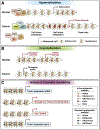Epigenetic Alterations in the Gastrointestinal Tract: Current and Emerging Use for Biomarkers of Cancer
- PMID: 33279516
- PMCID: PMC7878343
- DOI: 10.1053/j.gastro.2020.09.058
Epigenetic Alterations in the Gastrointestinal Tract: Current and Emerging Use for Biomarkers of Cancer
Abstract
Colorectal cancer, liver cancer, stomach cancer, pancreatic cancer, and esophageal cancer are leading causes of cancer-related deaths worldwide. A fundamental trait of virtually all gastrointestinal cancers is genomic and epigenomic DNA alterations. Cancer cells acquire genetic and epigenetic alterations that drive the initiation and progression of the cancers by altering the molecular and cell biological processes of the cells. These alterations, as well as other host and microenvironment factors, ultimately mediate the clinical behavior of the precancers and cancers and can be used as biomarkers for cancer risk determination, early detection of cancer and precancer, determination of the prognosis of cancer and prediction of the response to therapy. Epigenetic alterations have emerged as one of most robust classes of biomarkers and are the basis for a growing number of clinical tests for cancer screening and surveillance.
Keywords: Barrett’s Esophagus; Biomarkers; Chromatin; Colorectal Cancer; DNA; Diagnosis; Esophageal Cancer; Gastric Cancer; Histone; Methylation; Noncoding RNA; Pancreatic Cancer; Predictive; Prognosis; Treatment.
Copyright © 2021 AGA Institute. Published by Elsevier Inc. All rights reserved.
Conflict of interest statement
Conflict of Interests: WM Grady is on the advisory boards for Freenome, Guardant Health, and SEngine and consults for Diacarta. He is also an investigator for a clinical trial sponsored by Janssen and receives services for investigator initiated research from Tempus.
Figures



References
-
- Hanahan D, Weinberg RA. The hallmarks of cancer. Cell 2000;100:57–70. - PubMed
-
- Hanahan D, Weinberg RA. Hallmarks of cancer: the next generation. Cell 2011;144:646–74. - PubMed
-
- Epigenetics Herceg Z. and cancer: towards an evaluation of the impact of environmental and dietary factors. Mutagenesis 2007;22:91–103. - PubMed
Publication types
MeSH terms
Substances
Grants and funding
- P30 CA015704/CA/NCI NIH HHS/United States
- P01 CA077852/CA/NCI NIH HHS/United States
- U54 CA143862/CA/NCI NIH HHS/United States
- U01 CA206110/CA/NCI NIH HHS/United States
- R01 CA220004/CA/NCI NIH HHS/United States
- R01 CA207371/CA/NCI NIH HHS/United States
- R01 CA194663/CA/NCI NIH HHS/United States
- R01 CA189184/CA/NCI NIH HHS/United States
- P50 CA150964/CA/NCI NIH HHS/United States
- U01 CA086402/CA/NCI NIH HHS/United States
- R50 CA233042/CA/NCI NIH HHS/United States
- U01 CA182940/CA/NCI NIH HHS/United States
- U01 CA152756/CA/NCI NIH HHS/United States
- U54 CA163060/CA/NCI NIH HHS/United States
LinkOut - more resources
Full Text Sources
Other Literature Sources
Medical

